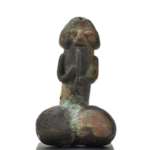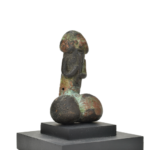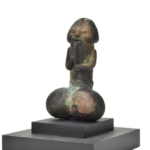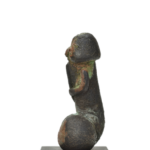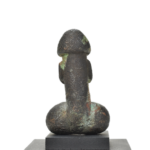Important Moche Phallic Copper Flutist
Intricate Details and Artistic Narrative of this
Moche Copper Phallus
This unique and exceptionally rare artifact from the Moche culture of ancient Peru is a stand-alone hollow copper phallus measuring 2.5 inches in length. It features a remarkable human element: the shaft’s underside represents the human body that incorporates arms and a flute. At the same time, the phallic top depicts a man’s head with detailed facial features. Overall, the imagery within the phallus is of a musician blowing on a flute. This intricate detail adds a layer of complexity and artistry to the piece. Additionally, the piece includes large testicles, enhancing its symbolic significance. This artifact is a fine example of Moche craftsmanship and symbolic artistry.
The Moche civilization is renowned for its rich artistic heritage, particularly in ceramics and metallurgy. This artifact is a testament to their advanced metalworking skills and complex views on sexuality and fertility.
Erect Phallic imagery was crucial in Moche’s art and symbolism, carrying deep cultural and religious significance. Integrating a human flutist element within the phallus conveys multiple layers of meaning. The flute is often associated with fertility and agricultural rituals, suggesting its use in ceremonies intended to invoke prosperity and divine favor. The depiction underscores the Moche’s sophisticated understanding of the interconnectedness of music, fertility, and spiritual well-being. Music, an integral part of Moche ceremonies, was believed to enhance ritual potency and communicate with the divine. The stature of an erect penis and large testicles further emphasize fertility and potency, making this artifact a powerful symbol within Moche cultural and religious practices.
The Moche achieved the creation of hollowed copper figures through several advanced metallurgical techniques. They often employed methods such as hammering and annealing, repoussé, and chasing to produce intricate designs with hollow forms.
Artisans would start by hammering copper into thin sheets. These sheets were then annealed, heating the metal to make it more malleable and easier to work with. They could shape the metal into hollow forms by hammering the copper sheets over molds or cores made from clay or stone. Once the desired shape was achieved, the molds or cores could be removed, leaving behind a hollow metal figure.
Repoussé and chasing were also essential in creating detailed hollowed figures. Repoussé hammered the metal from the reverse side to create raised designs while chasing refined designs from the front. This combination allowed for high levels of detail to be achieved on the hollow figures.
To construct more complex figures, the Moche used soldering and riveting to join separately made parts. For example, different sections of a figure, such as limbs or decorative elements like the facial features, could be created individually and then assembled. This method enabled the creation of elaborate and multi-part designs that retained their hollow nature.
Through these sophisticated methods, the Moche produced highly detailed and intricate hollowed copper figures like this phallus, showcasing their advanced metallurgical skills and artistic creativity.
Moche, Trujillo in the Moche River valley, Peru. c. 100 – 700 AD.
Condition: Excellent, with a natural patina consistent with age.
Provenance: Private Florida collection; Ex C. Ronzio collection, Eugene, OR – by way of inheritance. Acquired in the 1960s
Price: $5,850 – Domestic Delivery Included
- Explore comparable antiquities on display at renowned museums to appreciate the history and artistry behind our collection. Museum Collection Portal
- Click here to see our next selected item.
- Are you searching for a particular piece and not finding it? Let us help.
- Regional Division of Pre-Columbian Americas’ Major Archaeological Cultural Phases.
- Visit us here at the Native American Art Magazine

